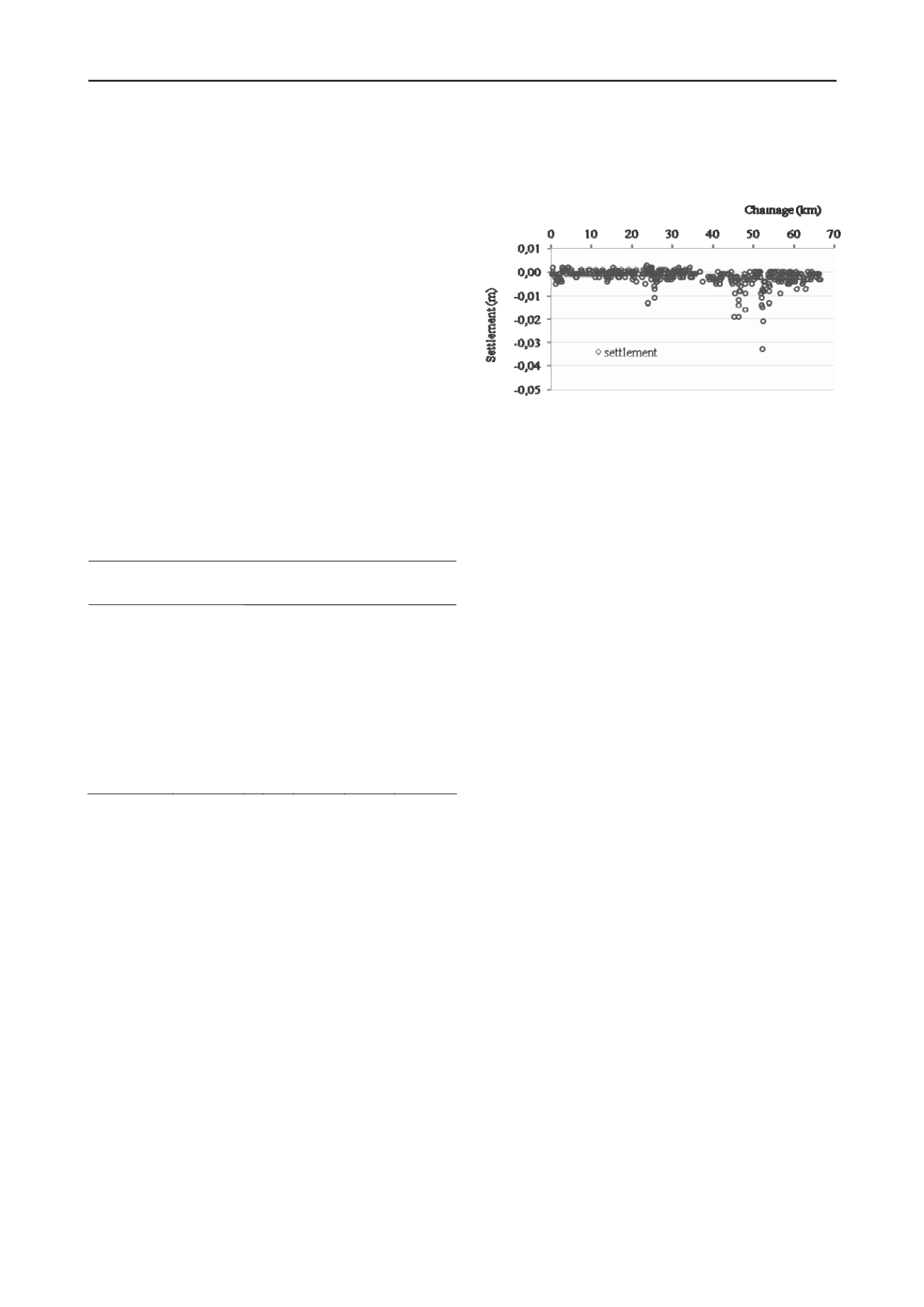
2952
Proceedings of the 18
th
International Conference on Soil Mechanics and Geotechnical Engineering, Paris 2013
percentage change of water content and void ratio values
obtained from peaty soil collected from the improved and
unimproved areas. Consolidation tests revealed that the
compression index of the peat layer has reduced from a range of
2.65 to 2.13, to as low as 0.90 as a result of the ground
improvement. The average reduced value is about 1.65. The
results of long term consolidation tests carried out in the
improved and unimproved peaty samples show that that the
coefficient of secondary consolidation has reduced from a range
of 0.10 to 0.13 to a range of 0.03 to 0.06. Subsequently the ratio
of
c
has decreased from 0.050 to 0.029 due to ground
improvement (Karunawardena and Nithiwana, 2009).
CC
/
Consolidation test results also indicated that the pre-
consolidation pressure of the peaty soil found under the
embankment has increased as shown in Table 2. Table 2 also
shows the expected load induced on the peaty layer due to the
proposed embankment and the subsoil over consolidation ratio.
According to the data in Table 2, the sub soil will behave under
the over consolidated state with an OCR of 0.98 to 1.33. It
should be noted here that even though the applied vacuum
pressure and the fill surcharge load is adequate to yield an OCR
value in the range of 1.2 to 1.3, sometimes the calculated OCR
is less than that the anticipated value. This might be due to the
inaccurate Preconsolidation Pressure (P
c
) value obtained from
the consolidation test as a result of sample disturbance.
Table 2. Increment of preconsolidation pressure and undrained cohesion
Location
Expected
Load
(kPa)
P
c
(kPa)
OCR
C
u
(kPa)
C
u
/ σ’
v
180
1.13
79.0
0.49
Ch.45.380-
Ch.45.430
160.0
160
1.00
57.0
0.36
200
1.37
55.0
0.36
Ch.47.850-
Ch.47.920
145.0
180
1.25
70.0
0.45
150
0.98
41.5
0.27
Ch.52.950-
Ch.53.000
152.5
170
1.11
38.2
0.25
Ch.53.660-
Ch.53.730
150.0
170
147
1.13
0.98
54.0
50.5
0.36
0.34
The strength gained due to ground improvement was
investigated by calculating the ratio between the undrained
shear strength of peaty soil and the effective stress (C
u
/ σ’
v
).
The ratio between the undrained shear strength of peaty soil and
the effective stress (C
u
/ σ’
v
) after the treatment program was
obtained to be 0.25 to 0.49.
5.3
Observed settlement after pavement construction
The surface settlement of the highway embankment constructed
over the improved soft ground was monitored by installing the
settlement markers at 50 m intervals after construction of the
road pavement. Initially, for about a 6 month period, before the
road was opened to traffic, surface settlement was monitored at
both the center and the edge of the embankment. The observed
settlements were in the range of 0 mm to 5 mm in most of the
ground improved sections except at very few locations where
high embankments were constructed over thick peat deposits
improved by the vacuum consolidation method. The observed
surface settlement in those areas was around 10 mm to 20 mm
at the end of six months after the construction of pavement.
After the highway was opened to traffic in November 2011,
settlement monitoring was carried out only along the edge of the
highway embankment due to safety reasons. The observed total
surface settlement up to September 2012, ten months after the
highway was opened to traffic, is shown in Figure 3. The
observed settlement was less than 5 mm in most of the sections
and in only two locations the settlement exceeded 20 mm. The
maximum observed settlement was 35 mm and the settlement
prediction using the monitoring data indicates that the estimated
residual settlement is less than 15 mm at the end of 3 years after
the handing over of the project.
Figure 3. Results of the surface settlement monitoring
6 CONCLUSION
This paper presents successful application of ground
improvement work carried out in the construction of Southern
Highway project in Sri Lanka. Ground improvement methods
such as heavy tamping method and vacuum consolidation
techniques were applied to construct the high embankments
over thick peaty deposits. In both methods, a surcharge load had
been applied to over consolidate the peaty soil. Field monitoring
data obtained during the construction period indicates that the
primary consolidation settlement due to final load of the
highway embankment has already been completed and the
secondary settlement had been reduced to control the residual
settlement within acceptable performance limits. Investigations
carried out at the site show that both physical and mechanical
properties of the peat have improved significantly and the peaty
soil will behave in an over consolidated state with a ratio of 1.2
to 1.3 during the service life of the highway. The results of the
post construction surface settlement monitoring of the
expressway carried out up to date reconfirm that the ground
improvement work was successful and the expected residual
settlements are well below the allowable limit in the contract.
7 ACKNOWLEDGEMENTS
The authors are grateful to the Road Development Authority of
Sri Lanka, for the necessary approval and support extended
towards writing this paper.
8 REFERENCES
Asaoka A. 1978. Observational Procedure of Settlement Prediction.
Soil
and Foundation
, 18(4): 87-101
Karunawardena A. and Nithiwana W. 2009. Construction of a trial
embankment on peaty ground using vacuum consolidation method
for a highway construction project in Sri Lanka. Proc. of 17
th
International Conference on Soil Mechanics and Geotechnical
Engineering. Alexandria,Vol. 3. 2200-2203.
Karunawardena A. and Toki M. 2011. Application of the Heavy
Tamping Method on Sri Lankan Peaty Clay for the Construction of
a Highway Embankment. Proc. of 14
th
Asian Regional Conference
on Soil Mechanics and Geotechnical Engineering. Hong Kong,
China.


